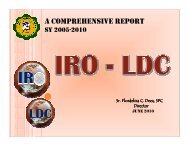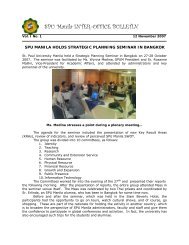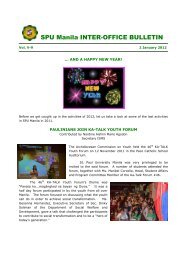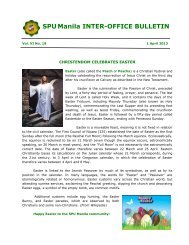Mr. Rodrigo Bongolan
Mr. Rodrigo Bongolan
Mr. Rodrigo Bongolan
Create successful ePaper yourself
Turn your PDF publications into a flip-book with our unique Google optimized e-Paper software.
Climate Change<br />
most serious<br />
threat of the world<br />
Due to greenhouse<br />
gases emitted<br />
from human<br />
activities
Global<br />
warming<br />
Floods<br />
Droughts
• Compromises food production<br />
of the country esp. in the Ilocos<br />
region.<br />
• Since agriculture is the most<br />
important sector of the economy<br />
that is highly dependent on<br />
climate.
With the present environmental<br />
scenario, it is necessary to<br />
identify agricultural crops and<br />
production systems that are<br />
suited to the locality and have a<br />
potential to sequester CO2<br />
the atmosphere.<br />
from
To determine and compare<br />
short-duration pigeon pea (ICPL<br />
88039) and mungbean as to the:<br />
amount of carbon dioxide<br />
sequestered<br />
agronomic characteristics
interaction effects of<br />
production systems, planting<br />
distances and seeding rates<br />
economic performance as to<br />
net income and return of<br />
investment (ROI)
Independent Variables<br />
Short-duration Pigeon pea<br />
(ICPL 88039)<br />
Production System<br />
Monocropping<br />
Row intercropping<br />
Planting Distances<br />
20 cm x 50 cm<br />
30 cm x 50 cm<br />
20 cm x 70 cm<br />
30 cm x 70 cm<br />
Planting Density<br />
2 seeds/hill<br />
3 seeds/hill<br />
4 seeds/hill<br />
Dependent Variables<br />
Carbon Sequestration<br />
Agronomic<br />
Performance<br />
‣Yield<br />
‣Growth<br />
Economic Potential<br />
Land Equivalent Ratio<br />
(LER)
Santiago, Ilocos Sur, Philippines
BLOCK I<br />
BLOCK II<br />
BLOCK III<br />
BLOCK IV<br />
A2B1C2<br />
A2B1C1<br />
A2B1C3<br />
A2B2C2<br />
A2B2C1<br />
A2B2C3<br />
A1B1C2<br />
A1B1C3<br />
A1B1C1<br />
A2B3C2<br />
A2B3C1<br />
A2B3C3<br />
A2B4C1<br />
A2B4C3<br />
A2B4C2<br />
A2B1C3<br />
A2B1C1<br />
A2B1C2<br />
A1B3C1<br />
A1B3C2<br />
A1B3C3<br />
A2B1C3<br />
A2B1C1<br />
A2B1C2<br />
A2B2C3<br />
A2B2C1<br />
A2B2C1<br />
A2B4C2<br />
A2B4C1<br />
A2B4C3<br />
A1B4C3<br />
A1B4C2<br />
A1B4C1<br />
A2B2C3<br />
A2B2C2<br />
A2B2C1<br />
A2B3C3<br />
A2B3C2<br />
A2B3C2<br />
A2B3C2<br />
A2B3C1<br />
A1B3C3<br />
A1B2C3<br />
A1B2C2<br />
A1B2C1<br />
A2B4C1<br />
A2B4C2<br />
A2B4C3<br />
A1B3C2<br />
A1B3C3<br />
A1B3C1<br />
A1B2C3<br />
A1B2C1<br />
A1B2C2<br />
A2B1C3<br />
A2B1C1<br />
A2B1C2<br />
A1B4C2<br />
A1B4C3<br />
A1B4C1<br />
A1B2C2<br />
A1B2C1<br />
A1B2C3<br />
A1B1C2<br />
A1B1C1<br />
A1B1C3<br />
A2B2C1<br />
A2B2C2<br />
A2B2C3<br />
A1B3C2<br />
A1B3C1<br />
A1B3C3<br />
A1B1C3<br />
A1B1C2<br />
A1B1C1<br />
A1B3C2<br />
A1B3C1<br />
A1B3C3<br />
A2B4C3<br />
A2B4C2<br />
A2B4C1<br />
A1B1C2<br />
A1B1C3<br />
A1B1C1<br />
A1B4C3<br />
A1B4C1<br />
A1B4C2<br />
A1B4C2<br />
A1B4C3<br />
A1B4C3<br />
A2B3C1<br />
A2B3C3<br />
A2B3C2<br />
A1B2C3<br />
A1B2C1<br />
A1B2C2<br />
FC FC FC FC FC FC<br />
FC FC FC FC FC FC<br />
Experimental Design: 2 x 4 x 3 in Split Split Plot Design<br />
Treatments:<br />
Main Plot – Production Systems Sub Plot – Planting Distances Sub sub Plot – Seeding Rates<br />
A1 – Monoculture B1 – 20 cm x 50 cm C1 – 2 seeds/hill<br />
A2 – Intercropping with mungbean B2 – 30 cm x 50 cm C2 – 3 seeds/hill<br />
B3 – 20 cm x 70 cm<br />
C3 – 4 seeds/hill<br />
B4 – 30 cm x 70 cm<br />
FC – Floating Control<br />
Experimental Layout of the Study.
Land Preparation<br />
<br />
Conventional tillage<br />
method<br />
Seed Requirements<br />
<br />
<br />
2 ½ kg of pigeon pea<br />
1 kg of mungbean<br />
Seed sowing<br />
Based on planting<br />
distance and seeding<br />
rates<br />
4-5 cm deep
Irrigation<br />
Prior to seed sowing<br />
Early growth<br />
Early podding stage<br />
Weed<br />
Management<br />
20-30 DAP<br />
50-60 DAP<br />
Pest and Disease<br />
Management<br />
Flower initiation<br />
Early podding stage
Harvesting<br />
‣ manual picking<br />
‣ 75% of the<br />
pods were<br />
matured
Carbon Sequestration<br />
Walkley-Black method<br />
Oven-dried samples/treatment<br />
Computation:
Data Gathered:<br />
A. Agronomic Parameters<br />
‣ Plant Height at Maturity<br />
‣ Days to Flower<br />
‣ Days to Maturity<br />
‣ Yield/ha
B.<br />
CO2 sequestration<br />
C. Land Equivalent Ratio<br />
(LER)<br />
D. Economic Parameters<br />
‣ Net Income (Php)<br />
‣ Return of Investment
1. Intercropped pigeon peas at 4<br />
seeds/hill registered the highest<br />
amount of CO2 sequestered at a<br />
rate of 13.25 t/ha which was<br />
comparable to monocropped<br />
pigeon peas with a mean of<br />
13.24 t/ha.
2. Monocropped pigeon peas at a<br />
seeding rate of 4 seeds/hill in a<br />
planting distance of 20cm x 70cm<br />
and 30cm x 50cm produced higher<br />
yield with a mean of 1,032.81kg/ha<br />
and 1,000.00 kg/ha, respectively<br />
which was significantly higher when<br />
compared to intercropped pigeon<br />
peas.
3. A maximum seeding rate of 3<br />
seeds/hill at a planting distance<br />
of 30cm x 70cm planted in<br />
monocropping system produced<br />
taller pigeon peas of 144.53cm<br />
which was significantly higher<br />
when compared to intercropped<br />
pigeon peas.
4. Pigeon peas planted 4 seeds/hill<br />
were found to be the earliest to flower<br />
(48.69 days) and mature (76.69 days).<br />
5. Higher LER was computed for pigeon<br />
peas planted 2 seeds/hill at 20cm x<br />
70cm planting distance having a value<br />
of 1.44. This means that<br />
intercropping is more efficient than<br />
monocropping system.
6. Monocropped pigeon peas generally<br />
generated higher net income and<br />
positive ROI as compared to<br />
intercrops. Further, higher number of<br />
seeding rate of 4 seeds/hill at 30cm x<br />
70cm obtained the highest income of<br />
Php 42,318.60 with an ROI of 2.154.<br />
However, all treatment combinations<br />
have a positive income and ROI.
1. A substantial amount of carbon<br />
dioxide was sequestered by<br />
pigeon peas at 4 seeds/hill<br />
regardless of planting distances.<br />
2. Monoculture of pigeon peas at 4<br />
seeds/hill produced the highest<br />
yield.
3. Pigeon peas planted at 4 seeds/hill<br />
have flowered and matured earlier.<br />
4. Pigeon peas in the 20cm x 50cm,<br />
30cm x 50cm and 20cm x 70cm at 2<br />
seeds/hill and 30cm x 70cm at 3 and<br />
4 seeds/hill have comparable land<br />
equivalent ratio (LER).
5. Highest net income and return<br />
of investment was observed on<br />
monocropped pigeon peas<br />
planted 20cm x 70cm at a<br />
seeding rate of 4 seeds/hill.
1. Short duration pigeon pea is a<br />
potential sequestrant of carbon<br />
dioxide, positively increased farmer’s<br />
income and food supply, thus<br />
planting of pigeon pea is<br />
recommended;<br />
2. 4 seeds/hill in monocropping system<br />
for higher yield.
3. 20cm x 50cm, 30cm x 50cm<br />
and 20cm x 70cm at 2<br />
seeds/hill and 30cm x 70cm<br />
at 3 and 4 seeds/hill in<br />
pigeon pea production for<br />
higher land equivalent ratio<br />
(LER).
4. Highest net income and return of<br />
investment (ROI) was observed<br />
on monocropped pigeon peas<br />
planted 20cm x 70cm at a<br />
seeding rate of 4 seeds/hill,<br />
hence, it is also recommended.
5. The same research endeavors should be<br />
conducted using other agricultural crops<br />
and locations to validate and generate a<br />
more conclusive results.<br />
6. Moreover, conduct of study on delaying<br />
or minimizing the release of CO2<br />
sequestered by pigeon pea after<br />
harvesting.
Comments and suggestions are welcome…<br />
RODRIGO L. BONGOLAN JR.<br />
Agusan del Sur State College of Agriculture and Technology<br />
Mobile No.: 09059232730<br />
Email Add: bhongski11277@yahoo.com

















